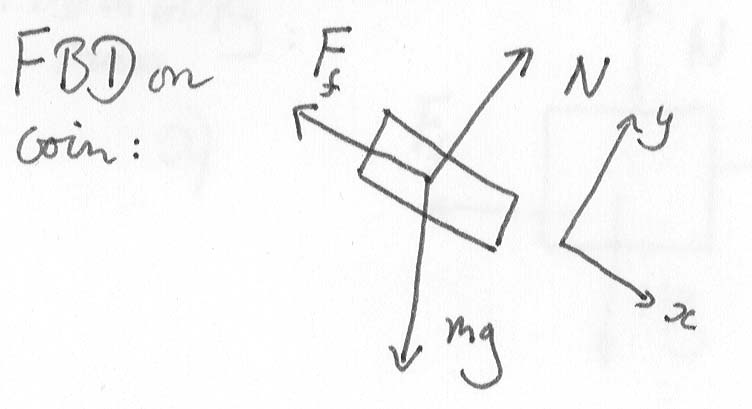Problem 1:
A coin of mass = 4 g lies on a copy of Tipler's physics textbook, which
is being tilted at an angle ![]() with
respect to the horizontal. The coefficient of static friction between the
coin and the book is
with
respect to the horizontal. The coefficient of static friction between the
coin and the book is ![]() s
= 0.4 and the coefficient of kinetic friction is
s
= 0.4 and the coefficient of kinetic friction is ![]() k
= 0.3.
k
= 0.3.
a) Find the maximum angle ![]() at
which the book can be tilted before the coin will start to slide.
at
which the book can be tilted before the coin will start to slide.
b) Assume the book is tilted at an angle of 60°. What will be the kinetic energy of the coin after it has a slid a distance l = 15 cm along the cover of the book?
Solution:
Draw a Free-body diagram for the coin:

Apply F = m a to the coin, and we get:
(x) mgsin![]() -
Ff = max = 0 (the
coin does not slide)
-
Ff = max = 0 (the
coin does not slide)
(y) N - mgcos![]() = 0 (no acceleration in y-direction)
= 0 (no acceleration in y-direction)
We also have
Ff ![]()
![]() s
N
s
N
The maximum angle before sliding will be when the frictional force is at its maximum, so we have
Ff = ![]() s
N =
s
N = ![]() s
mgcos
s
mgcos![]()
Thus we have from the x-equation
mgsin![]() -
-
![]() s
mgcos
s
mgcos![]() =
0
=
0
thus
![]() s
= sin
s
= sin![]() /cos
/cos![]() =
tan
=
tan![]()
![]() =
arctan(
=
arctan(![]() s
) = 21.8°
s
) = 21.8°
b) The change in kinetic energy is the work done by the net force; the net force acting on the coin is
F = mgsin![]() -
-
![]() k
mgcos
k
mgcos![]()
where we use kinetic friction, since coin is sliding. The work done is
W = F![]() x
= F l = (mgsin
x
= F l = (mgsin![]() -
-
![]() k
mgcos
k
mgcos![]() )l
= 4.21 x 10-3 J
)l
= 4.21 x 10-3 J
Alternate solution : We can calculate the acceleration using a = F/m where F is as above, then use
vf2 = v02
+ 2 a![]() x
x
to solve for the final velocity vf and then calculate the kinetic energy as ½ mv2
Problem 2
Test 2
Physics 101 Home
page
Physics Department Home Page
College of William and Mary,
Dept. of Physics